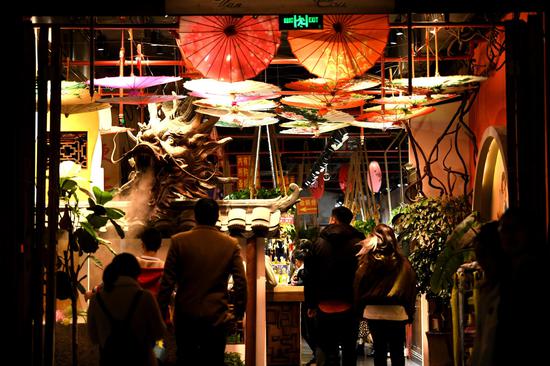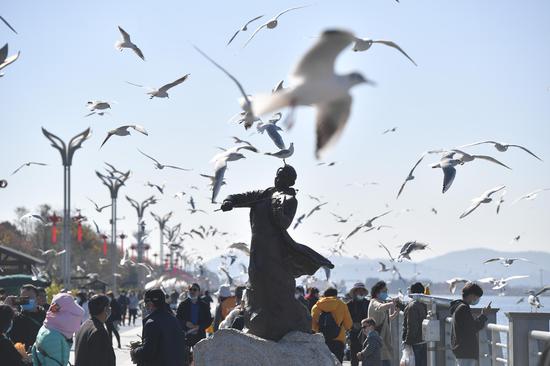
Tourists view the statue of the Leshan Giant Buddha in Leshan City, southwest China's Sichuan Province, March 23, 2020. (Xinhua/Zhang Chaoqun)
The world's largest stone Buddha statue, the Giant Buddha of Leshan, needs a repair, again.
Less than three years after the completion of the latest large-scale facelift -- the seventh in over a century -- the 71-meter-high statue sitting outside the city of Leshan, southwest China's Sichuan Province, already suffers from a black nose and a dirty face.
Besides, parts of the Buddha's chest, abdomen, hands and legs are now covered with moss and other plants, giving it an entirely different appearance from the one freshly repaired in April 2019.
Over the weekend, Leshan hosted a seminar that saw renowned Chinese experts discuss a new restoration plan for the statue. This time around, however, rather than giving the Buddha another makeover, they decided to address the root cause of its degradations, hoping to give the sculpture extended years of health.
The Buddha statue, carved into a cliff in Leshan Mountain and overlooking three converging rivers, was built over a 90-year period beginning in 713 during the Tang Dynasty (618-907).
"The seminar marked a significant change of our approach from 'curing the symptoms' to 'curing the disease while curing the symptoms,'" said Zhan Changfa, former deputy president of the Chinese Academy of Cultural Heritage (CACH).
Experts reached the consensus that among many other factors, damage from water, rain and humidity contributed the most to the degradation.
"First and foremost, we need to address the problem of damage from water, otherwise any facelift would be nothing but a stopgap measure," Huang Kezhong, a researcher with the CACH, told the seminar via video link from Beijing.
The experts at the seminar agreed that addressing the water damage involves a multi-faceted approach covering areas such as geological survey, monitoring and evaluation, material research and environmental restoration.
Zhan pointed out some critical questions for systematic planning and step-by-step solutions, which include --Where are the internal cracks? How to deal with weathering? What materials are better to use for the repair? Should an awning be built? Should a cap be put on tourist numbers?
Zhan added that given the natural and geographic conditions of the Buddha statue's location, the restoration plan aims for "better health, less fatal diseases, and ideally a longevity" for the Buddha, rather than finding a cure-all.
Wang Yi, head of Sichuan Provincial Cultural Heritage Administration, said experts from home and abroad will conduct in-depth cooperation and multidisciplinary research on the protection of the giant Buddha.
The Leshan Buddha was inscribed on the UNESCO World Cultural Heritage list in 1996.


















































 京公网安备 11010202009201号
京公网安备 11010202009201号